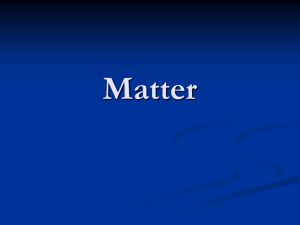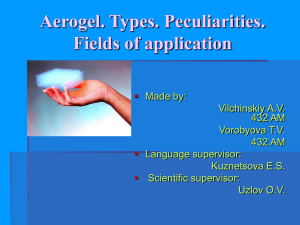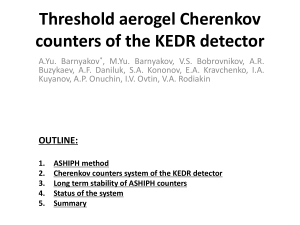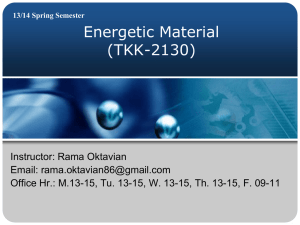Document
advertisement
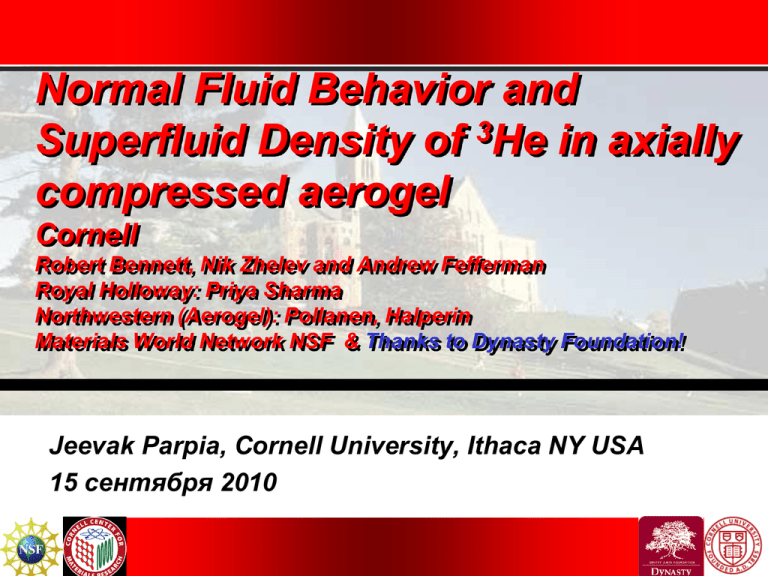
Normal Fluid Behavior and Superfluid Density of 3He in axially compressed aerogel Cornell Robert Bennett, Nik Zhelev and Andrew Fefferman Royal Holloway: Priya Sharma Northwestern (Aerogel): Pollanen, Halperin Materials World Network NSF & Thanks to Dynasty Foundation! Jeevak Parpia, Cornell University, Ithaca NY USA 15 сентября 2010 Introduction 0. Background 1. Description of experimental arrangement 2. Normal Fluid measurements and assumptions a. Results b. Discussion 3. Expected effect of uniaxial compression on superfluid 4. Past measurements of ρs/ρ in aerogel 5. Superfluid density and dissipation in compressed aerogel 6. Future work and Conclusions 2 0. Study heff , rs of impurity-limited 3He Usual measurements on TO employ a right circular cylinder. Unsuited for normal state measurements. In this geometry, the normal component is not well-clamped leads to large dissipation (Q-1). Will use the Q-1 and frequency shift to establish the effective viscosity of the normal fluid. Equivalent to resistivity of normal state in a superconductor. Such a measurement could also be used to yield the impurity limited viscosity in the superfluid phases and other useful parameters. R. Nomura, G. Gervais, T.M. Haard, Y. Lee, N. Mulders, and W.P. Halperin, Phys. Rev. Lett., 85 4325 (2000). The attenuation of 14.6 MHz sound for 3He in aerogel. Dashed line: calculated by the viscoelastic model. The dot-dashed line includes a decoupling effect. The attenuation in bulk 3He (solid line) is shown for comparison. 3 I: Aerogel Sample Aerogel grown at Northwestern inside a stainless steel cavity, id 6.95 mm, target height 400mm. After drying, the shims were carefully removed and a nominal force applied to the faces of the cavity to achieve 10% compression. The aerogel was optically characterized through small holes in the cavity wall before (after) compression to verify the lack (presence) of an optical anisotropy axis as described in Pollanen et al. The cavity was embedded in an epoxy head on a double pendulum torsional oscillator. Stainless cell for aerogel. Radial holes allow for optical characterization of the aerogel. J. Pollanen, J.P. Davis, B. Reddy, K.R. Shirer, H. Choi, and W.P. Halperin, J. of Phys. Conf. Ser. 150 032084, (2009). 4 1- Background (dissipation and period) The background period and Q-1 were measured at const. amplitude. The cell was filled at >5 K to ~ 5 bar, cooled to 0.1K, and pressure lowered to 0.14 bar, 3 bar etc. The period and Q were measured to 0.5 mK. The Q-1 and period for empty (Pe , Qe) and 0.14 bar 3He filled cell. The background is fitted (solid line) and subtracted from P(T) to obtain period shift and the dissipation due to the “dirty” Fermi fluid together with any (small) bulk contribution. 6 2a- Normal state behavior Q-1 after background subtraction Qf-1= Qmeas-1- Qe-1 Fraction of inertia decoupled = 1-[P(T)-Pe(T)]/[P(T=0)-Pe(T=0)] Red Lines show expected behavior for 3He filling a 400 µm cavity (without aerogel) With aerogel present, Fluid velocity profile shows velocity profile shows viscous penetration “Drude-like” character: depth no << channel width variation in fluid velocity across channel width. As Viscous(resistivity) penetration depth viscosity =0.5 channel width increases, the velocity profile shows a smaller Viscous penetration relative velcity to walls.depth Thus >>fluid channel width solidthe approaches body rotation. V=0 V=0 V=0 7 2a- Normal state behavior Q-1 after background subtraction Qf-1= Qmeas-1- Qe-1 Fraction of inertia decoupled = 1-[P(T)-Pe(T)]/[P(T=0)-Pe(T=0)] Red Lines show expected behavior for 3He filling a 400 µm cavity (without aerogel) Dashed red line shows behavior for a scaled bulk cavity of height 340µm with an inertia of 0.75% of fluid Subtract scaled behavior from data to obtain contribution to dissipation and fraction decoupled from aerogel 8 2a- Aerogel acts as an impurity for Fermi Liquid Landau – Fermi liquid theory shows viscosity η and mean free path, in ~ T-2, due to decreasing excitation density as T decreases. The quasiparticle-quasiparticle mean free path (inelastic scattering) increases as the temperature is lowered and is ~ 100 µm at 1 mK. Aerogel introduces an additional elastic scattering mechanism, e. 3500 Å Since the scattering rates add, τ -1=τe-1 + τin-1, is limited by elastic scattering at low temperatures. Thus η and are bounded from above. 9 2b-Analysis of Normal State Results Calculate the effective viscosity from the measured dissipation of the aerogel-Fermi liquid mixture. The inferred viscosity is very large. We have to find some method by which the stiffness of the aerogel matrix is taken into account. One way would be to introduce a collection of point scatterers quasi-one dimensional rods embedded in the liquid. 10 2b-Analysis of Normal State Results For simplicity we replicate the stiffness of the aerogel by a collection of space-filling slabs, each spaced a distance “tslab ” from each other. Such a collection of slabs would lock the fluid to the torsional oscillator, the same way as the 3He is locked to the aerogel structure. The viscosity of the 3He would still be limited by the elastic scattering of quasiparticles from the aerogel. tslab 11 2b-Analysis of Normal State Results If the slabs are filled with “pure” bulk 3He, we expect that the dissipation will vary as the slab separation is altered. Here we show the result with a slab separation of 4.15 µm. When we introduce a mean free path limited viscosity, we see that there is now much better agreement with the background and bulk subtracted data. Fit parameters are: t bulk = 340µm, fraction bulk 0.0075, tslab = 4.15 µm, =0.15 µm 12 2b-Analysis of Normal State Results We use exactly the same procedure and parameters to fit data obtained in the normal state for 3 bar. Dissipation fit for impurity limited viscosity is still excellent, the mass decoupling is not well replicated. This is understandable since the slab model would give a smaller mass decoupling than a rod model or point scatterers. Fit parameters are: t bulk = 340µm, fraction bulk 0.0075, tslab = 4.15 µm, =0.15 µm 13 2- Summary of normal state • We can accurately assay the dissipation and mass decoupling in the normal state • These reveal that there is a crossover to impurity dominated transport where the mean free path is set by elastic scattering from the aerogel. • We find a long mean free path =0.15 µm • Correlation of impurity scattering length may be used to predict Tc suppression (eg via Abrikosov-Gorkov model). • Tc in this sample should be much higher than in usual 98% open aerogel. 14 2- Summary of normal state – A-G model Tc 0 1 r 1 ln , digamma function 2 2 2 Tca r /(2 k BTca ), vF Tca From G-L theory one expects rs / r Tco 2 2 2 0 • Such an analysis should allow us to link Tc suppression to mean free path (normal state properties) and ρs once phase diagram is mapped out. 15 3-“Dirty” superfluid phases & stability TA*→B Tcaerogel (P) A B Nazaretski, Mulders, Parpia JETP Lett. 79, 470 (2004) In ordinary “isotropic” 98% open aerogel, it is common to observe a large region of A – like (A*) phase when cooling. Contrast to the extent of A phase in the bulk. Question why does the A phase occur so reliably and over such a broad extent in aerogel when cooling? Is it nucleated from some precursor state in the so called normal fluid? 16 3 - Larkin-Imry-Ma state Could the A* phase be the Larkin-Imry-Ma state? In such a state, l should be pinned by fluctuations of random orientations of impurities. This should be modified by compression which would restore the A like phase and yield (ρs/ρ) . ┴ See Volovik Journal of Low Temperature Physics, 150, p. 453-463 (2008). 17 3 - Bulk ρs/ρ Results (ρs/ρ) ┴ (ρs/ρ) ║ In the bulk, A phase superfluid density can be greater or less than that of the B phase, (depends on texture). (ρs/ρ)// ~ 0.5 (ρs/ρ)B Without a field, textural alignment is unlikely. (ρs/ρ)// <(ρs/ρ)B (ρs/ρ) > (ρs/ρ)B ┴ Is the A phase correctly identified? See Fomin, JLTP, 79, 134 (2004). Berthold, Giannetta, Smith, Reppy, PRL 37, 1138 (1976). 18 4 - 3He A, B phase Superfluid density in Aerogel No sign of A phase on warming? Finite width of TA→B. (ρs/ρ)A< (ρs/ρ)B Nazaretski, Mulders, Parpia JETP Lett. 79, 470 (2004) 19 4- Making mixtures of A and B in aerogel Main figure: Mixture made by cooling into TA→B. Inset: Mixture made by warming into TB→N or TB→A band. Nazaretski, Mulders, Parpia JETP Lett. 79, 470 (2004) 20 4- Superfluid density ratio Superfluid density in A phase is ~½ that of B phase, suggests (ρs/ρ)// Results at 3 different pressures at right. Nazaretski, Mulders, Parpia JETP Lett. 79, 470 (2004) (rAs/r)/(rBs/r)0.5 21 4- Superfluid density in magnetic fields Ratio of rs/r A* and B phase, hysteresis does not change with field. Range of expected B→A* transition No B → A* transition seen on warming? Evidence for superheating? Is the A* phase the stable phase between normal and the B phase? Nazaretski, Lee, Parpia Phys Rev. B 22 4- B→A* transition only seen in higher field In experiments at Northwestern using sound, A→B and B→A transitions were seen in higher magnetic fields but not in low fields. Gervais et al Phys. Rev B. Nazaretski, Lee, Parpia Phys Rev B 23 4 - Polycritical point Polycritical point (bulk) 1 TAB / Tc g ( )(B / B0 ) 8 2 kBTca B0 1 F0a 7 (3) ( 2 ) For 3He in usual 98% open aerogel, the polycritical point is eliminated Gervais, Yawata, Mulders and Halperin, PRB 66 054528 (2002) 24 5- Superfluid density in compressed aerogel Proposed Experiment Measure the dissipation and period shift of 3He. Expect to see: 1. Broader region of A phase 2. rsA > rsB since l should be perpendicular to flow, yielding (ρs/ρ) ┴ 3. A phase to reappear on warming. Need high precision to resolve superfluidity in impurity limited 3He near Tc from that of small amount of bulk fluid. 25 5-Measurements at 25.7 bar in superfluid state We measure period shift and dissipation in the superfluid state while warming and cooling. The region below Tc has numerous 2nd sound resonances. These resonances occur at the same values of rs/r while cooling and warming. rs/r in the A phase is less than that of the B phase (contrary to expectation). 26 5-Measurements at 29.1 bar in superfluid state (rs/r) A cooling < (rs/r) B warming (contrary to expectation). Same effect is seen at 25.7 bar Width of A B transition essentially unchanged in compressed aerogel. 28 bar 27 5-The A to B Transition Dissipation and rs/r near the A*-B transition. The A* phase converts gradually to the B phase with at least one jump in dissipation. The dissipation decreases while rs/r increases as the A* transforms to the B phase. On warming there is no evidence for a B- A* transition in this region. 28 5-The A to B Transition- (dissipation) Dissipation and rs/r near the A*-B transition. We see a two step transition in the dissipation as the 3He converts from A phase to B phase. Note the width of the transition is not rate dependent and shows the effects of pinning. In contrast the bulk transition occurs over a negligible time (temperature) interval. We see the bulk transition at the same temperature as that in the fork T/Tc(bulk) 29 5-Region near Tc at 29.1 bar rs/r near the onset of 29.1bar bar 29.2 Tc bulk superfluidity shows some unexpected behavior. We see a clear bulk fluid transition that coincides with the transition seen in a vibrating quartz fork. At a lower temperature we see a kink in the resonant period marked as Tc aerogel. At a slightly lower temperature we see a divergence of warming and cooling data that we believe is evidence for a zero field TB→A transition. 30 5-Compare regions near Tc at 25.7 and 29.1 bar Focus on the B→A transition on rs/r near the onset of superfluidity. 29.2 bar At this point in time (two pressures examined) there is some evidence for a B→A transition on warming. Turn around experiments also show that the state (A phase or B phase) is altered depending on which side of the point marked TB→A we warm the cell to. 31 5-Compare rs/r to previous experiments rs/r (A phase) shows continuous change with temperature (ie power law is different from B phase result). Quite different from results in uncompressed aerogel. But not similar to bulk behavior or what was expected from original experiment. (rAs/r)/(rBs/r)0. 5 32 5-Compare rs/r to previous experiments rs/r is only slightly enhanced in the present experiment compared to previous results. Inconsistent with G-L model. 33 5- “Dirty” superfluid phases & stability From Pollanen et al. This work Pollanen (uncompressed) Isotropic compression of the aerogel should result in a preferred axis. The expectation is that the A phase should be stabilized by uniaxial compression. We find the A phase extent is broadened by compression. We do (tentatively) see a B→A transition in zero magnetic field in compressed aerogel. There should also be a textural orientation effect. Flow measured perp. to compression should sample an enhanced rsA. Such an enhancement was not observed. 34 5-“Dirty” superfluid phases & stability TA*→B Tcaerogel (P) A B In ordinary “isotropic” 98% open aerogel, it is common to observe a large region of A – like (A*) phase when cooling. Contrast to the extent of A phase in the bulk. We see a much enhanced Tc (correlated to long mean free path in normal state?). We also see enhanced stability region for the A phase. Also see some evidence for recurrence of the A phase on warming. 35 5- Hysteretic dissipation signature Dissipation is seen to decrease abruptly at low temperature (deep in B phase). Recovers on warming with differing amounts of hysteresis. Possibly related to vortex-core transition? Will investigate by cooling through Tc without oscillation, examine at other pressures. J.P.Pekola et al, Phys. Rev. Lett., 53 584 (1984). 36 5- Dissipative transition? TA*→B Tcaerogel (P) A B Thuneberg . 37 5- Phase diagram Tc Suppression Simple model for Tc suppression 35 Aerogel Tc calculated Pressure (Bar) 30 Bulk Tc 25 Aerogel Tc measured 20 15 10 5 0 0 0.5 1 1.5 2 2.5 Temperature (mK) (T , P)T a constant for a particular aerogel = L o 50.2nm c Use L0 0 (1 Tca / Tco )1/ 2 to generate phase diagram as a function of pressure 38 6 - Future Normal state: • Measure/analyze results at higher pressures. • Develop better model for hydrodynamics in hybrid system • Compare results for consistency across all pressures Superfluid • Map phase diagram (Tc, TA→B, TB→A) as a function of pressure • Correlate phase diagram to in normal state • Pursue dissipative transition • Re-examine low pressure region for quantum phase transition. 39 6 - Conclusions Conclusions Normal state: • Single step aerogel is different: has longer scattering length, less suppression of Tc. Superfluid • Compressed aerogel does increase metastable region of A phase, but no alignment of rs/r. • Possibly see A phase reappear on warming – connection to bulk phase diagram. Viscosity is different in A and B phases. • See dissipation signature at low temp in B phase? Is it connected to Vortex transition? Check by rotation? • Relate Tc suppression to mean free path (normal state transport). 40
